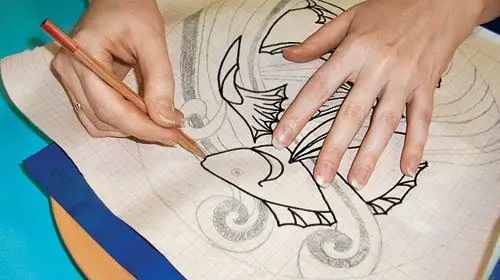Recently, old crafts and crafts have been reviving to life, already as hobbies and hobbies. Various embroidery is very popular among home craftswomen, with its help they decorate tablecloths, pillows, clothes, handkerchiefs, make panels on the walls. Regardless of the way you are going to embroider, satin stitch, ribbons, cross stitch or using a machine, you somehow have to transfer the pattern to embroidery before starting work.

It is necessary
- - decals;
- - transfer pencil;
- - copy paper;
- - tracing paper or tissue paper;
- - fabric (cambric, organza, muslin, veil);
- - pen or chalk;
- - iron.
Instructions
Step 1
First, decide which pattern you will be doing and choose the fabric. Purchase special ink transfers on vellum paper, or select designs printed on plain paper. In the first case, for translation, simply attach the decal to the fabric and iron with an iron until the contours are clearly visible.
Step 2
The second case includes four ways of transferring a pattern to fabric. Use any of the methods below to transfer the design to the fabric.
Step 3
Take a transfer pencil, put tracing paper on the drawing and trace the contours of the drawing with a transfer pencil. Then attach the tracing paper to the fabric (pencil drawing down) and iron with an iron. Hold the iron until the pattern appears on the fabric, checking from time to time to see if the fabric is burning. Remember that this method is best for fabrics that are not afraid of high temperatures. If you don't like the result, wash the cloth with soap and water.
Step 4
To transfer the design to a smooth fabric using carbon paper, use light paper for dark fabrics and dark paper for light fabrics. Place it on the fabric with the ink side down, and lay the pattern on top. Trace the outline of the drawing with a pen or pencil. If possible, do not touch or press in places where there is no pattern, otherwise extra spots may appear there.
Step 5
Transfer the drawing directly onto the fabric if it is thin and transparent, for example cambric, organza, muslin, veil. Just put a bright enough drawing, pin the fabric on top and trace the emerging contours with a pencil or chalk.
Step 6
If the drawings cannot be transferred to the fabric using an iron or other methods, then proceed as follows: draw a pattern on tissue paper or tracing paper, remember it a little, and attach to the fabric with pins or sew with a few stitches. Embroider straight through the paper when you're done, just tear off any remaining design. This removes the paper easily and leaves the embroidered design on the fabric.






